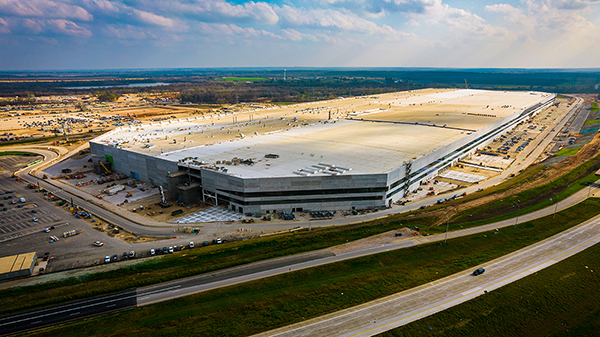Gigafactories have presented new challenges to the construction industry requiring a unique approach to design, planning and innovation.

By Padraig Leahy, Director at Linesight
As electric vehicles (EVs) have become more and more popular, all major EV manufacturers have identified battery production as a key consideration in the expansion of their market. Battery components were a significant cost driver in the overall expense of early EVs, but in recent years, investments in research, innovative new technology, and manufacturing processes have helped reduce costs and increase production. The EV industry could not make enough batteries to meet demand and scrambled to boost manufacturing quickly. To maximize the efficiency of battery production, EV companies have pioneered a new type of enormous manufacturing facility, now commonly called a gigafactory, both for its sheer size and for the gigawatt-hours of energy the batteries themselves produce.
Gigafactories themselves generally follow the basic principles and production flow of any manufacturing facility — receiving raw materials at one end, manufacturing in the middle, then packing and storage, with shipping at the other end of the process. Because the EV revolution is driven by the desire to reduce fossil fuel usage, innovation in relation to energy consumption and waste management is also a factor. But it’s impossible to deny the main differentiator is the sheer scale of the buildings: the Tesla factory in Nevada covers some 5.3 M square feet of space. Giga Shanghai, Tesla’s third Gigafactory, is only slightly smaller at 4.5 M square feet. Compare these to the Boeing factory outside of Seattle — the world’s largest building by volume sports only 4.2 M square feet of space.
These giant facilities have presented new challenges to the construction industry, requiring a unique approach to design, scheduling, planning and innovation, due to the sheer scope of each project and the immediate demands of the EV industry to get batteries into cars and cars to the market as quickly as possible. Scheduling is critical, yet these projects are by nature both demanding and untested, requiring innovation, as well as expertise and confidence to deliver facilities on time.
Battery manufacturers want the fastest timelines at the lowest costs, which is not a new concept for construction teams. But techniques for gigafactory construction are still in their infancy, as only a small number of the 200-plus gigafactories planned by 2050 have been completed. To date, construction teams have adopted a combination of using the latest in integrated project management tools alongside significant off-site prefabrication to deliver these huge buildings in the required timeline. Fortunately, construction companies can leverage existing and emerging resources to successfully complete even the largest gigafactory projects.
Both integrated design, and the universal use of project and design management software by all team members, are critical to Gigafactory development. Early participation should involve a fully integrated team, including the operator and all design, cost, scheduling, contractor and specialist positions. Successful, integrated teams have adopted project management software, which contains tools that provide each team member with real-time information on all aspects of the design and development. These software suites include tools such as 3D modelling, scheduling, estimating, and budgeting modules. This integrated approach has allowed scheduling and cost teams to continually provide estimated final costs and completion dates at each stage of the pre- and post-contract process. Some elements of the building can also be prefabricated before other design elements are completed using this advance information.
One particularly valuable software tool for gigafactory construction is Building Information Modelling (BIM), which provides a 3D picture of the proposed project. The more data that is fed into the system, the more adaptive and interactive a model it can create. With enough information, a BIM system can calculate what any given change in design will mean for the final project. For example, when redesigning a room in the gigafactory, BIM can determine how much more or less concrete and steel will be needed, based on changes either to the room in question or to the rest of the facility, as well as how this will affect the budget and timeline. When preparing for a project as massive as a gigafactory, detailed designs with the flexibility to account for any contingencies can be the key to finishing on time and under budget.
Off-site production is a reliable and smart choice for building industrial facilities, but scale and speed remain a key differentiator and complication when it comes to gigafactories. Delivery teams recognize that the various components of the building must be manufactured concurrently rather than sequentially to ensure the schedule is maintained. Due to the sheer scale of major components like walls and roofs, only off-site fabrication allows assets of that size to be completed simultaneously in multiple locations, then assembled at the site at the necessary speed.
Gigafactory production is so sizeable that entire sections of the facility can be built at once without interfering with one another. Assuming off-site modular prefabrication goes as scheduled, different teams can construct a gigafactory in broader phases, with multiple modules going up with minimal risk. This dramatically cuts time off production, as Tesla did to complete Giga Berlin in just over a year. With proper preparation and design, and a reliable production and delivery pipeline, a gigafactory can be built much faster than such a structure would suggest, precisely because its size allows for simultaneous independent sub-projects.
Effective procurement strategies and supply chain management will ensure the timely completion of a gigafactory project. Because modular construction is readily available at any scale, a contractor who orders their components from multiple sites is limited only by how fast they can assemble the pieces. But sourcing components from multiple providers requires flexibility and good, strong supplier relationships, so it is vital to find the right partner for procurement as early in the design process as possible. That way, parts are coming in from all providers as soon as it’s time to break ground.
Gigafactories are massive structures requiring massive investment, careful planning and logistical expertise. If companies intend to produce enough lithium-ion batteries to fill the demand for EVs, contractors must be ready to build on a whole new scale. With the relevant construction consultant expertise in place to support the speed and cost control needed on these huge projects, these massive facilities can be built with minimal headaches.

Padraig is a Director at Linesight with over 30 years of experience in the commercial, hospitality, healthcare, and infrastructure sectors. He has worked on large-scale projects across South America, the Caribbean, the United States, Canada, and Europe. As a chartered Cost Manager, he has a track record of managing projects with large contractors and providing cost-saving solutions for clients. Padraig’s areas of expertise include project controls, subcontract management, claims management, and bonding insurance.
In this episode, I sat down with Beejan Giga, Director | Partner and Caleb Emerson, Senior Results Manager at Carpedia International. We discussed the insights behind their recent Industry Today article, “Thinking Three Moves Ahead” and together we explored how manufacturers can plan more strategically, align with their suppliers, and build the operational discipline needed to support intentional, sustainable growth. It was a conversation packed with practical perspectives on navigating a fast-changing industry landscape.